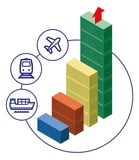The 5 Best Moves When JIT Can't Win - Just In Case
Keith LaBotz - January 20, 2022

Everstream Analytics 2022 Risk Report lists ocean freight bottlenecks as one of the top 5 risks for supply chains. While the problem of port congestion is obvious, something bigger is brewing beneath the surface, and it will force your business to change.
146 container ships were anchored off major US ports last week, setting a new record for port congestion. It would take 2-3 months of 24 x 7 operation and no new arrivals to clear this backlog. That‘s not going to happen.
The transportation crunch behind the port crisis isn't improving, which spells trouble for supply chains. Transportation is at the core of every supply chain, and as transportation goes, so goes the supply chain. The underlying causes of the transportation crunch will take months, even years, to resolve. Something must give before then, and it already did - the economy.
Prepare for What’s Coming
2021 concluded with a 40 year high for inflation, declining consumer demand in December, and industrial output dropping. Economists are pinning it on transportation disruptions, and there is no end in sight right now.
Without resolving the sources of supply chain dysfunction, economic forces will clear port congestion for us by reducing supply and demand. The overhead of sustaining the global supply chain will downsize with it until transportation capacity is in equilibrium. That's a longwinded way of saying “recession”.
Switch from JIT to Just In Case
Lockdowns exposed weak links in “just in time” systems and one of them is transportation. Transportation was never really JIT - it’s inherently volatile; there is a lot of variability due to environmental factors like weather, traffic, equipment problems, and port congestion.
Switching from JIT to a “Just In Case” operation aligns business processes more closely with transportation. This will keep your business lean and more responsive to volatility, allowing your processes to weather a recession caused by faltering transportation networks.
Prioritize Shipment Visibility
Increasing visibility is the most effective step your company can take to shield itself from the transportation problem and deterioration of freight networks.
A business can only eliminate threats it can see, so monitoring everything coming and going in your supply chain is an essential step in risk reduction. According to a Forbes survey, 90% of supply chain executives believe supply chain visibility is vital to success. Agree, and I’ll add that your company should concentrate on shipments.
Shipment visibility solutions from cloud providers like Project 44 provide the location and status of orders, SKUs, and containers in transit.
For delivery operations, flexis ProfiTOUR is an excellent solution, reducing costs by up to 60% for labor and 20% for transportation. Data captured by these solutions also play a vital role in supply chain planning and optimization.
Shipment tracking collects information vital for reducing risk, such as shipment transit times on supplier shipments. Knowing how much time is required to deliver an SKU makes alternative routing options easier to evaluate - and automate with solutions like ProfiTOUR.
This data fuel predictive analytics for running delay scenarios, finding alternative suppliers, and routing shipments via alternative ports and transportation modes. Determining the financial impact on your company can make it easier to optimize your supply chain.
Identify Weak Links
Your supply chain is only as strong as its weakest link, so identifying them is vital. The objective is to keep material and data moving. The questions below will help you identify and resolve the weak links. Predictive analytics can run scenarios to assess the impact of changing suppliers, carriers, and routes to ensure SKUs are delivered on time.
-
Which SKUs are most critical, and where is their origin?
-
Is the mode of transportation at risk of disruptions?
-
Is there a backup supplier for an SKU?
-
Is an alternative mode of transportation available?
-
How reliable (timely, accurate, and complete) is incoming data from a supplier?
-
How reliable is data from customers for forecasting and production planning?
-
Which SKUs experience the most extended transit times and delays?
-
Which ports are associated with delayed SKUs?
Rerouting Shipments
- Ports of entry that are not bogged down can be used as alternative destinations. Smaller ports are too shallow for larger container ships and may have fewer trucks servicing the facility.
- Routing shipments with rail or air freight can offer an alternative to keep certain products or orders moving. While air freight is more expensive, sometimes it's justified to avoid the higher cost of potential production outages and lost sales.
Increase Buffer Inventory
Increasing safety stocks of critical components or best-selling products are insurance against transportation disruptions.
Onshoring Suppliers
According to McKinsey, 26% of global trade is best suited for reverting to domestic suppliers. Sourcing from domestic suppliers can bring multiple wins:
-
Avoiding ocean port congestion and geopolitical instability.
-
Reduced transit times, transportation costs, and greenhouse emissions.
-
Strengthens local economies and fosters deeper integration.
Conclusion
Port congestion is pointing to something bigger - economic headwinds from an unsustainable situation that requires switching from JIT to a Just in Case model. Scenario planning around transportation volatility will become more important until the transportation crunch resolves.
In the meantime, keep your eye on port congestion.
Click below to download our guide on The Leaner Greener Challenge.
LATEST POSTS
- Understand Circular Economy in The Manufacturing Industry
- How Can Industry 4.0 IT Integration Be Achieved Smoothly?
- The Significance of Order Sequencing in Discrete Manufacturing
- How to improve your Supply Chain Management: The Power of Control Towers
- Optimizing Human Resource Scheduling in Manufacturing: A Technological Approach



